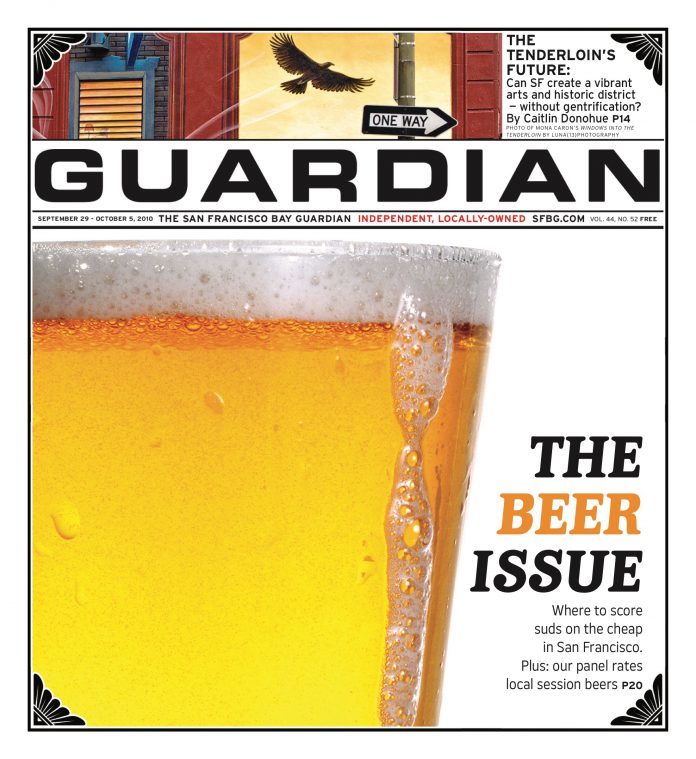arts@sfbg.com
HAIRY EYEBALL Two life-size sculptures of human skulls sit side by side at Meridian Gallery. The first is cast in glass, tiny air bubbles filling its dome like frozen stars. The one to the right, the wall card indicates, is actually human, but you wouldn’t know it since it’s covered in black leather. The seamless second skin is pulled tight around the bone, as if shrink-wrapped. The effect is both helmet- and lifelike, making you immediately want to run your fingers across your head and face, feeling the tautness of your flesh, aware, at the same time, of what’s contained by such penetrable softness.
Bringing out the sentient in the inanimate is one function of certain forms of shamanism, but it could also serve as description of art making as well. It certainly applies to the practice of Toronto-based, African American artist Tim Whiten, whose work, by turns affecting and frustratingly opaque, is the subject of Meridian’s career-spanning overview, “Darker, Ever Darker; Deeper, Always Deeper: The Journey of Tim Whiten.” This is Whiten’s third show with the gallery, and his return is always something of personal one: his close friendship with exhibit curator and Meridian director Anne Trueblood Brodzky goes back decades.
With its use of natural, sometimes found materials — cotton, coffee, leather, wood, stone, bone, glass — and ritualistic air, Whiten’s art frequently gives off the impression of having been excavated rather than created in a studio, as if what fills Meridian’s three floors are the assembled artifacts from some now-vanished indigenous people. (This is an artist whose most well-known piece, Metamorphosis, involved him being sewn into — and then wriggling out from — a bear skin turned inside-out ). As Robert Farris Thompson’s essay in the accompanying catalog painstakingly details, Whiten’s work consciously takes inspiration from and evokes a network of traditions and objects (his “visual ancestry” in Thompson’s words) that stretches from the daily rituals of his late woodworker father to the bone yards of the American South to the totems of the Ejagham people of southwestern Camaroon.
Although such context is helpful, possessing it does not give a more overtly referential sculpture such as Magic Staffs (1970) — two wooden sticks wrapped in leather with dangling bits of animal bone and human hair — the same charge as Whiten’s far simpler leather encased stones from the same period. As with the leather-wrapped skull (Parsifal, 1986), Whiten’s covering of the stones serves to underscore the natural processes by which their shapes came to be while also reconstituting them as something more mammalian.
Two large canvases from the mid-to-late 1990s, Enigmata (no. 11) and Enigmata with Rose (no 4.), work in the reverse by displaying just the covering: in this case, hospital sheets, stained with coffee. Their chestnut brown wrinkles and creases suggest skin, as well as the bodies who once laid on and beneath them, leaving their marks in blood and sweat, giving birth to new life and passing on from this one. They are by far the most touchingly human pieces in “Darker.”
DARKER STILL
Darker still are the photos of Rudolph Schwarzkogler at Steven Wolf’s spacious new Mission District digs. “Castration Myth” documents the intense 1960s actions the late Vienna Aktionist carried out in front of a few spectators in his apartment. The indeterminacy of what’s happening in these photos (the exhibit takes its title from the apocryphal story that Schwarzkogler amputated his own penis in one performance) still causes unease, even if the Aktionists’ anti-aesthetic — in which the artist’s body is pushed to its limits, trussed up, battered, and defiled — has become metabolized into pop culture by way of punk rock and, more recently, the prurient sadism of the Saw films.
DARKER, EVEN DARKER; DEEPER, ALWAYS DEEPER: THE JOURNEY OF TIM WHITEN
Through Nov. 26
Meridian Gallery
535 Powell, SF
(415) 398-7229
RUDOLPH SCHWARZKOGLER: CASTRATION MYTH
Through Oct. 9
Steven Wolf Fine Arts
2747 19th St., A, SF
(415) 263-3677

